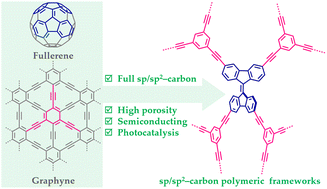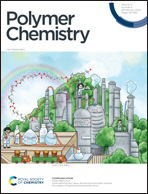Semiconducting three-dimensional polymeric frameworks with full sp/sp2-carbon skeletons for efficient photocatalysis†
Abstract
Nanocarbons have become a popular study focus because of their exceptional conductivities, substantial redox behaviours and excellent stability. In this work, deriving from the key segments of promising nanocarbon materials, such as fullerene and graphynes, we developed two conjugated porous polymers consisting of sp and sp2 carbons, termed SH-CMP-1 and SH-CMP-2 upon a transition metal-catalyzed Sonogashira cross-coupling reaction, where tetrabromo-9,9′-bifluorenylidene (9,9′-BF-4Br) and phenylacetylenes serve as the crucial building blocks for the formation of π-extended skeletons over the three-dimensional space. Their chemical and porous structures were characterized by solid-state NMR spectral analysis and nitrogen sorption isotherms with high surface areas of up to 587 m2 g−1 and 615 m2 g−1. Tubular morphologies were observed for both porous polymers. In combination with their substantial semiconducting properties as revealed by UV-vis spectroscopy and cyclic voltammetry, the as-prepared CMPs enable efficient photodegradation of dye molecules such as methylene blue (MB) and rhodamine B (RhB) under the irradiation of visible light when compared with most previously reported polymer photocatalysts. Selective MB degradation in the MB + RhB mixture in such porous polymers was also observed. The photocatalytic mechanism study indicates that the major reactive species involved in photodegradation are oxygen and electrons.



 Please wait while we load your content...
Please wait while we load your content...